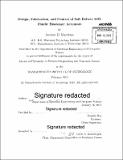| dc.description.abstract | The goal of this thesis is to explore how autonomous robotic systems can be created with soft elastomer bodies powered by fluids. In this thesis we innovate in the design, fabrication, control, and experimental validation of both single and multi-segment soft fluidic elastomer robots. First, this thesis describes an autonomous fluidic elastomer robot that is both self-contained and capable of rapid, continuum body motion. Specifically, the design, modeling, fabrication, and control of a soft fish is detailed, focusing on enabling the robot to perform rapid escape responses. The robot employs a compliant body with embedded actuators emulating the slender anatomical form of a fish. In addition, the robot has a novel fluidic actuation system that drives body motion and has all the subsystems of a traditional robot on-board: power, actuation, processing, and control. At the core of the fish's soft body is an array of Fluidic Elastomer Actuators (FEAs). The fish is designed to emulate escape responses in addition to forward swimming because such maneuvers require rapid body accelerations and continuum body motion. These maneuvers showcase the performance capabilities of this self-contained robot. The kinematics and controllability of the robot during simulated escape response maneuvers are analyzed and compared to studies on biological fish. During escape responses, the soft-bodied robot is shown to have similar input-output relationships to those observed in biological fish. The major implication of this portion of the thesis is that a soft fluidic elastomer robot is shown to be both self-contained and capable of rapid body motion. Next, this thesis provides an approach to planar manipulation using soft fluidic elastomer robots. That is, novel approaches to design, fabrication, kinematic modeling, power, control, and planning as well as extensive experimental evaluations with multiple manipulator prototypes are presented. More specifically, three viable manipulator morphologies composed entirely from soft silicone rubber are explored, and these morphologies are differentiated by their actuator structures, namely: ribbed, cylindrical, and pleated. Additionally, three distinct casting-based fabrication processes are explored: lamination-based casting, retractable-pin-based casting, and lost-wax- based casting. Furthermore, two ways of fabricating a multiple DOF manipulator are explored: casting the complete manipulator as a whole, and casting single DOF segments with subsequent concatenation. An approach to closed-loop configuration control is presented using a piecewise constant curvature kinematic model, real-time localization data, and novel fluidic drive cylinders which power actuation. Multi-segment forward and inverse kinematic algorithms are developed and combined with the configuration controller to provide reliable task-space position control. Building on these developments, a suite of task-space planners are presented to demonstrate new autonomous capabilities from these soft robots such as: (i) tracking a path in free-space, (ii) maneuvering in confined environments, and (iii) grasping and placing objects. Extensive evaluations of these capabilities with physical prototypes demonstrate that manipulation with soft fluidic elastomer robots is viable. Lastly, this thesis presents a robotic manipulation system capable of autonomously positioning a multi-segment soft fluidic elastomer robot in three dimensions while subject to the self-loading effects of gravity. Specifically, an extremely soft robotic manipulator morphology that is composed entirely from low durometer elastomer, powered by pressurized air, and designed to be both modular and durable is presented. To understand the deformation of a single arm segment, a static physics-based model is developed and experimentally validated. Then, to kinematically model the multi-segment manipulator, a piece-wise constant curvature assumption consistent with more traditional continuum manipulators is used. Additionally, a complete fabrication process for this new manipulator is defined and used to make multiple functional prototypes. In order to power the robot's spatial actuation, a high capacity fluidic drive cylinder array is implemented, providing continuously variable, closed-circuit gas delivery. Next, using real-time localization data, a processing and control algorithm is developed that generates realizable kinematic curvature trajectories and controls the manipulator's configuration along these trajectories. A dynamic model for this multi-body fluidic elastomer manipulator is also developed along with a strategy for independently identifying all unknown components of the system: the soft manipulator, its distributed fluidic elastomer actuators, as well as its drive cylinders. Next, using this model and trajectory optimization techniques locally-optimal, open-loop control policies are found. Lastly, new capabilities offered by this soft fluidic elastomer manipulation system are validated with extensive physical experiments. These are: (i) entering and advancing through confined three-dimensional environments, (ii) conforming to goal shape-configurations within a sagittal plane under closed-loop control, and (iii) performing dynamic maneuvers we call grabs. | en_US |
